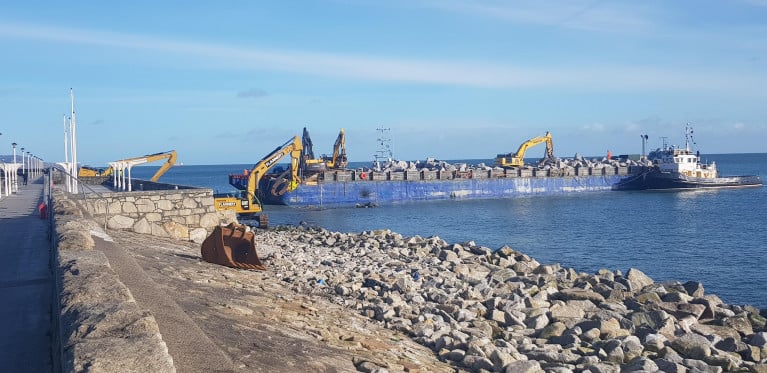Displaying items by tag: East Pier, Dun Laoghaire
Barge Departs But Works to Shore-Up Storm Damage Continue at E. Pier, Dun Laoghaire Harbour
Works to repair damage at the East Pier, Dun Laoghaire Harbour in Dublin Bay, that began last year on coastal defences should be completed in the coming weeks, writes Jehan Ashmore.
According to Dun Laoghaire-Rathdown County Council the works to replenish rock-armour from the damage caused by Storm Emma in 2018 should be completed by the end of March.
As Afloat previously reported a barge laden with 1,700 tonnes of Cornish granite boulders are being used to repair the outside of the East Pier.
Such work to position the rocks where required to shore-up coastal defences, is clearly evident when seen from the shores of Scotsman Bay as the new rocks are grey in colour compared to the surrounding slopes along the East Pier.
It is almost a fortnight since the barge towed by tug, Vanguard, departed Dun Laoghaire Harbour and back to the UK. DLRCoCo also confirmed to Afloat that this was the only shipment used in the project where contractors hired by the council are using heavy machinery.
The machinery involving digger/grabbers had to be tranported by sea (landing craft, James) from within the harbour to the outside of the East Pier due to accessiblility reasons.
Dun Laoghaire's Maritime Museum to Re-Open
#MARITIME MUSEUM-The much awaited re-opening of the Maritime Museum in Dun Laoghaire, Co. Dublin is to take place in April, writes Jehan Ashmore.
The museum which is near to Dun Laoghaire Harbour's East Pier, is to reopen on Tuesday 3rd April between 11am t- 5pm. Throughout the season, these same visiting hours apply Tuesdays to Sundays, though the museum will be closed on Mondays.
To read more about the initial exhibits on display (click HERE) in the apt surroundings of the former Mariners Church, where major and essentail renovation work took place over several years. The museum which is run by the Maritime Institute of Ireland (M.I.I.) celebrated its 70th anniversary last year and with the reopening they can now look forward to a new and exciting era.
Located on High Terrace, a Cul-de-Sac that links the town's main shopping thoroughfare on Georges Street Upper to The Metals, the pedestrian walkway –is only minutes away from the Dun Laoghaire DART station.
Car parking is limited in the immediate vicinity though there are car-parking facilities nearby in the Pavilion which is accessed along the harbour waterfront (Queens Road) and the Dun Laoghaire Shopping Centre approached from Marine Road.
In addition to visiting the museum the M.I.I. also welcome members and volunteers to assist in hosting lectures, producing newsletters, journals, a library, hosting and supporting commemorations in addition to conducting research and highlighting Irelands maritime heritage. For further information click HERE.
- Dublin Bay News
- Dun Laoghaire Harbour News
- Dun Loaghaire Harbour
- Mariners Church Dun Loaghaire
- Maritime Institute of Ireland (M.I.I.)
- M.I.I.
- Dun Laoghaire Shopping Centre
- Pavillon Car Parking
- The Metals
- Dun Laoghaire DART station
- Dun Laoghaire Harbour''s East Pier
- East Pier, Dun Laoghaire
- Irish maritime heritage
- Irish maritime museums






























































